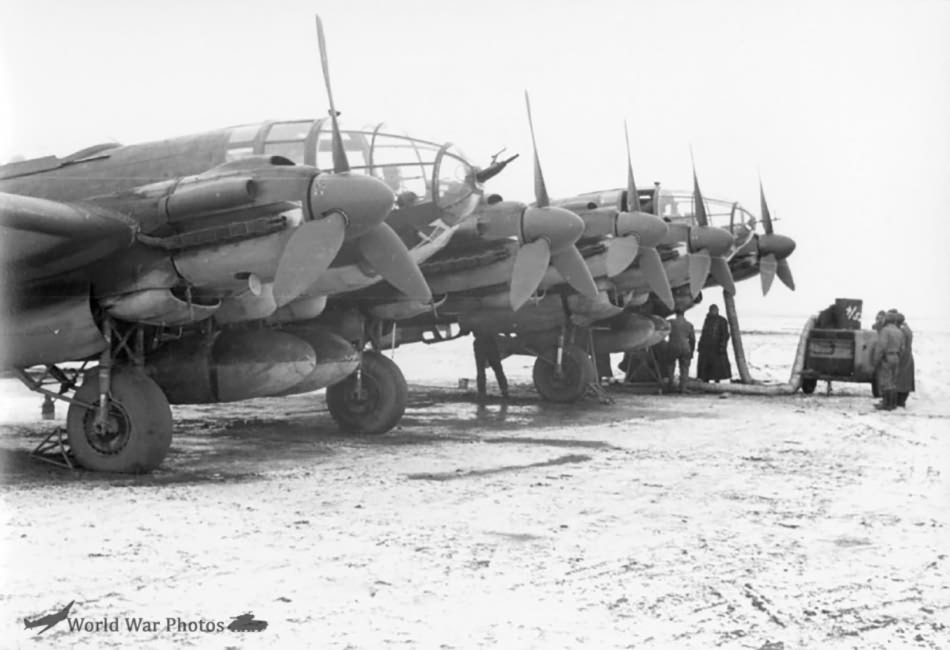The Heinkel He 111Z, also known as the “Twin Heinkel He 111” or “He 111 Zwilling,” was a highly distinctive and unusual variant of the Heinkel He 111 bomber, designed primarily for heavy glider towing operations. It represented a significant modification within the He 111 family of aircraft.
Design and Configuration: The most striking feature of the He 111Z was its unique construction: it was created by joining two standard He 111 airframes together with a new center wing section. This central wing section also housed an additional engine, resulting in a total of five engines for the aircraft. The aircraft retained the fully-glazed nose characteristic of the H-series variants from which it was derived. This design was noted by the British as a “strange heavy towing aircraft”.
Powerplant: The He 111Z was powered by five Junkers Jumo 211 engines. Specifically, the He 111Z-1 utilized Jumo 211F-2 engines. In the initial five aircraft, the three engines on the central wing section were Jumo 211-2 engines, rated at 1340 hp, while the two outer engines (on the original He 111 airframes) were Jumo 211-1 engines, rated at 1200 hp.
Dimensions and Performance (He 111Z-1):
• Wingspan: 35.4 meters (116.1 feet).
• Length: 16.4 meters (53.7 feet). This refers to the length of each individual He 111 fuselage that formed the Zwilling.
• Height: 4.0 meters (13.1 feet).
• Empty weight: 21,300 kg (46,957.7 pounds).
• Maximum take-off weight: 33,600 kg (73,995.7 pounds).
• Maximum speed: 400 km/h (248.6 mph) at an altitude of 6,000 meters (19,685 feet).
• Cruising speed: 344 km/h (213.7 mph).
• Service ceiling: 10,200 meters (33,464.6 feet).
• Range: 2,000 km (1,242.7 miles) with maximum fuel.
Armament: The typical defensive armament of the He 111Z-1 included seven 7.92mm MG 15 machine guns, positioned with one in the nose, one dorsal, one beam, and four in ventral positions.
Operational Purpose and History: The primary role of the He 111Z was to tow large cargo gliders. It was specifically designed to tow Gotha Go 242 cargo gliders and the much larger Messerschmitt Me 321 “Gigant” gliders. The He 111Z concept was born from the realization that the Me 321 gliders were practically useless due to the lack of suitable tugs.
The first He 111Z aircraft entered service on February 1, 1943, with I. Gruppe of LLG 1 (Luftlandegeschwader, Air Landing Wing). These aircraft saw significant use on the Eastern Front during large-scale supply operations. Units like Transportgeschwader 3 (TGr.30) were equipped with He 111Z aircraft.
Despite its innovative design and crucial role, the effectiveness of the glider-towing operations was sometimes unsatisfactory, particularly when attempting to deliver supplies to encircled German forces. Fewer than 20 He 111Z aircraft were built. Proposed later variants, the He 111Z-2 and Z-3, were also envisioned as heavy bombers or for towing larger gliders like the Me 323. The He 111Z was a clear example of wartime improvisation, modifying a successful airframe to fulfill a critical logistical need.
He 111Z Winter
Published at 950 × 650 px.
Link to full-size photo:
He 111Z Winter
Site statistics:
Photos of World War II: over 26800
aircraft: 63 models
tanks: 59 models
vehicles: 59 models
guns: 3 models
units: 2
ships: 47
WW2 battlefields - 12
weapon models: -
equipment: -
